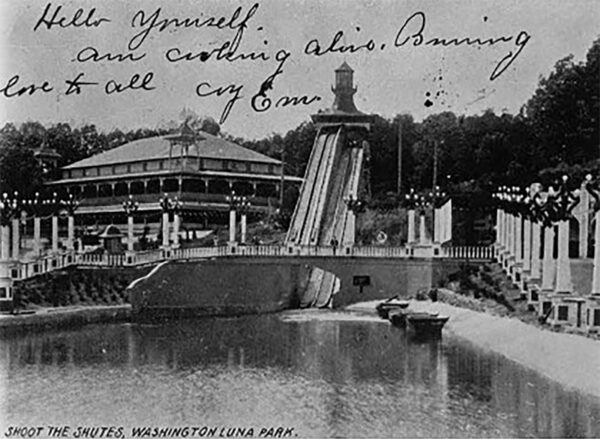
Before Six Flags and Busch Gardens, Luna Park, on what is now the Arlington-Alexandria border, was the go-to amusement park for D.C. area residents.
Opening a few years after the turn of the 20th century, the local Luna Park — it was part of a chain of dozens of parks — featured everything from roller coasters to circus performances. In one famous incident, reminiscent of the recent zebra escape in Maryland, a pack of elephants broke loose from the park during a storm and terrorized unsuspecting local residents for more than a week.
Memories of the park and the elephant escapades are included in local journalist, historian and Falls Church News-Press columnist Charlie Clark’s new book, Lost Arlington County. The book, which was released Monday, “provides a compendium of gone-but-not-forgotten institutions, businesses, homes and amusements.”
Clark shared with ARLnow an excerpt on Luna Park, below.
Arlington bid to be a regional playground at the dawn of the twentieth century. A vacuum in the entertainment market was created after commonwealth’s attorney Crandal Mackey’s cleanup of saloons and brothels in Rosslyn and Jackson City.
Pittsburgh entrepreneur Frederick Ingersoll spent $350,000 to build, near the rail line and Four Mile Run at the Arlington-Alexandria border (the edge of today’s Crystal City), what promoters called “unquestionably the grandest and most complete amusement and recreative place between the great ocean resorts.”
When it opened in May 1906, Luna Park was forty acres of tackiness with space for three thousand picnickers, restaurants, a circus arena and a ballroom in varying Gothic, Moorish and Japanese themes. At night, attendees were thrilled to behold fifty-one thousand electric lights. A 350-foot-tall inclined chute spilled riders into an 80-foot-deep lagoon.
The press enthused: it was like “a silver city set with diamonds,” said the Washington Post. Guests were entertained by Liberati’s sixty-piece band and by the Bessie Valdare All-Girl English Bicycle Team, as reported in a 2012 narrative by Jim McClellan and Shirley Raybuck in the Northern Virginia Review. Their article “The Pachyderm Panic of 1906” is the most detailed account of an oft-told tale that has brightened books on Arlington since the 1950s.
To liven the offerings at Luna Park, impresarios brought, by boxcar, four live elephants from Coney Island, New York. The much-hyped act, Barlow’s Elephants, arrived in August 1906 as a procession of the animals debarked from a Potomac barge. Dubbed Queenie, Annie, Jennie and Tommy, the elephants were trained to perform tricks, such as playing barber and shaving a man. But on that first night, a violent storm hit Alexandria County, which frightened the pachyderms that were chained together inside their hippodrome. They began kicking equipment (destroying an ice cream vendor’s cash register). To the screams of onlooking women and men, three made their escape.
“Across country, over ditches, fences, cornfields and right through barns, the trio lumbered at a speed which challenged the best the horses could do,” the Washington Post wrote.
Owner Peter Barlow assembled a posse to give chase. But after a fruitless day, he offered a reward and soon called in reinforcements from the crew of Wild West entertainer Pawnee Bill, who happened to be in the area. The beasts ended up in the Arlington and Fairfax areas of Bailey’s Crossroads, Burke, Lincolnia and as far south as Clifton. Farmers were furious at their trampled fences.
In Glencarlyn, a Miss Backus on South Fifth Street was playing along a stream but dashed home, terrified of the strange noises rising from the woods. One eleven-year-old boy in Alexandria, as recalled in the 1980s by his daughter, the late bookseller Irene Rouse, was driven by the shrieking noise to hide under his back porch, thinking he was being punished for a bad deed. He was awakened by the sound of “a great pounding of hoofs and the bellowing of tropical animals,” Rouse wrote. “Looking out from under the porch at the huge stomping feet, he was terrified and felt instant remorse for his earlier wrongdoing.”
After eight days, the marauding performers were finally caught — only Barlow himself could calm them down — and loaded onto a train at Burke Station on the Alexandria Leesburg rail line.
Luna Park flourished for a time, but it did not fare well after World War I broke out. On April 19, 1925, a fire destroyed the roller coaster and damaged other features. That ended the enterprise, and the lot devolved into a stagnant breeding ground. It became Arlington’s sewage treatment plant.
The exotic memory of Luna Park continues to reverberate among Arlingtonians. Preservation Arlington activist Eric Dobson, in 2021, worked with the county land records staff to produce a precise plat of the amusement park site, which, he assures the author, was “not completely along Four Mile Run and covers only a portion what is now the treatment plant.”
A prolific writer on local topics, Clark recently released another book, a biography of George Washington Parke Custis, and is the author of the 2014 book Arlington County Chronicles.

